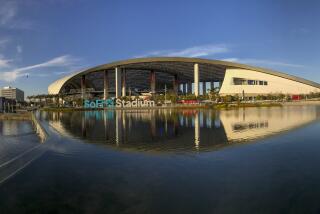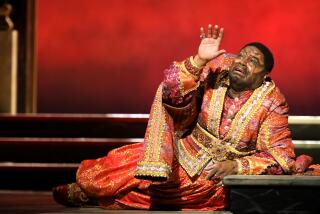A look back at the Boyle Heights melting pot
Bill Phillips’ name doesn’t often show up in histories of L.A.’s Eastside. But he, as much as anyone, helped foster its cultural renaissance.
From a storefront on the old Brooklyn Avenue, he sold guitars, violins and assorted other instruments, giving out free lessons on just about anything that could make music. He stocked a cabinet with saxophone reeds and rented out amplifiers that boomed at many a backyard party and social-hall concert.
Phillips’ customers, in turn, provided the soundtrack to the social and cultural transformations that defined the Eastside in the 1960s, ‘70s and beyond. Members of Chicano Rock groups like Los Lobos, Thee Midniters, and Ollin all visited Phillips Music Co. at different stages of their careers.
All this happened in a distinct interval in Eastside history, a few decades in the middle of the 20th century when L.A.’s Jewish history and its Latino history and Japanese American history intersected in Boyle Heights.
“It was this mix of all these kinds of people together.” said Bruce Phillips, Bill’s son, who is now a professor at Hebrew Union College in Los Angeles. “There was this sense that they are the same as we are, they’re nice people and they’re our friends.”
It’s one of the great secrets of our history that L.A. has always been a culturally diverse place where races and creeds mix freely. You can see this in many relics and records from the city’s past: from the roster of names buried in L.A.’s original Catholic cemetery to the 1930s novels of John Fante.
And yet, larger forces have always pulled L.A. apart, especially in those places where working people live. In Boyle Heights, a kind of de facto segregation has lately taken root — the community is more than 95% Latino. When Bruce and others who know its history speak of Boyle Heights, they often use the phrase “the L.A. that might have been.”
Phillips Music Co. closed in 1989 and Bill Phillips died in 1995. But his sons have worked to preserve his legacy.
Bruce Phillips, 62, is now a sociologist specializing in the demography of Jewish communities in the U.S. When I asked him why Jews thrived in and then left Boyle Heights, he spun a colorful neighborhood narrative that concluded with the unexpected entry of that grim-faced villain called “economics.”
During his family’s years there, Boyle Heights was to the West Coast what the Lower East Side was to New York, Bruce told me. It was a haven for many working-class Jewish families, and a hotbed of their political activism. There was the orthodox Breed Street Shul, but also many secular Jews who supported left-wing and labor causes.
Bill Phillips and his wife, Hannah Catch, came to escape the austere lives they led in other corners of the U.S.
Hannah was born in Texas, the daughter of a family with roots in New York’s Lower East Side, Bruce said. “On her birth certificate, under race, it says ‘Jew,’” he said.
Bill was one of nine children and ran away from his Rochester, N.Y., home as a teenager to join the Navy. He ended up in Long Beach, and while on leave was introduced to Hannah in Boyle Heights.
By then, Hannah was living in the back of a dress shop on what was then Brooklyn Avenue, having dropped out of school to work there. They married in 1933. Phillips then toured the U.S. playing in vaudeville bands, finally settling back in Boyle Heights, where he opened his music store in 1936.
Soon, the store, at 2455 Brooklyn Ave., was a community fixture, its windows gleaming at night.
For Bruce, the spirit of Phillips Music Co. is best symbolized by a photograph he has of his father from the late 1940s: it shows Bill standing behind a glass case displaying sheet music for “Jewish Melodies” and “Música Mexicana.”
Bill Phillips knew what his customers wanted.
He volunteered at Variety Arts Boys Club on Brooklyn, teaching kids to play drums. It was there that he met a young activist named Edward Roybal, a future member of Congress who was the grandfather of Latino political power in Southern California.
“He was the first treasurer for Eddie Roybal’s campaign for City Council,” Bruce said.
When Kenji Taniguchi returned to Boyle Heights after years spent in internment camps during World War II, Bill offered him a corner of his storefront for his own business, “Kenny’s Sporting Goods.”
As a teenager in the late 1960s, Bruce worked in the store, helping musicians rent amplifiers, and then listening to them “jam and riff” outside.
“I’d have 35 cents in my pocket and shop for a guitar pick and go in there to look at the music books,” Scott Rodarte of the group Ollin remembers, in one of a series of interviews conducted by the writer Josh Kun and collected on the website phillipsmusiccompany.tumblr.com.
The Phillips family eventually moved to the Crenshaw District. Brooklyn Avenue was rechristened Avenida Cesar Chavez. The diversity that exists in Boyle Heights today is exclusively Latino: Central American families living alongside Mexican immigrants and Mexican Americans.
But for Bruce Phillips, “white flight” from Boyle Heights was fueled by economics, not racism.
He blames “redlining,” the banking practice of not granting home loans in certain ZIP Codes, and the construction of several freeways through Boyle Heights; the home where Bill and Hannah met was demolished to make room for the 5 Freeway.
Those things made it less attractive for middle-class people to stay, he said. And so middle-class people — of all races — moved out. “Redlining pushed Jews out,” Bruce said. “They just couldn’t buy homes there anymore.”
With his generosity and love of music, Bill Phillips made the Eastside a better place to live. But the cultural integration he helped nurture in L.A. needed more than tolerance to keep it going.
Boyle Heights is still home to dressmakers and runaways, entrepreneurs and lovers of music. But if they speak more Spanish and Spanglish these days than English or Yiddish, it’s because of decades of government policies and banking practices that kept L.A. from being the city it might have been.
More to Read
Start your day right
Sign up for Essential California for news, features and recommendations from the L.A. Times and beyond in your inbox six days a week.
You may occasionally receive promotional content from the Los Angeles Times.







